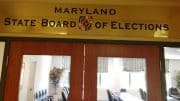The Maryland Board of Public Works voted to advance Gov. Larry Hogan’s traffic relief plan in June 2019.
Mr. Hogan first introduced his traffic relief plan in September 2017.
Comptroller Peter Franchot (D) voted with Hogan, but former State Treasurer Nancy K. Kopp (D) voted no.
The Public Works vote designated Mr. Hogan’s traffic relief plan as a public-private partnership.
The P3 designation allowed Hogan and his administration to solicit and evaluate private investment funds to bankroll the project.
You should know five things that happened during the June 2019 Board of Public Works meeting.
Listen to this panel discussion podcast from July 2020 that unwinds Larry Hogan’s traffic relief plan.
1) The Opposition to Hogan’s Traffic Relief Plan
Some of the plan’s opposers who spoke before the Public Works board seemingly failed to understand the nuts and bolts of the process.
The Public Works board voted to designate Hogan’s traffic relief plan as a public-private partnership.
That’s it.
The Board of Public Works vote allowed the Hogan administration to begin soliciting private investment funds.
Many of the opposing groups spread misinformation throughout social media that day.
Doing so ramped up the drama and caused unnecessary confusion.
Montgomery County Executive Marc Elrich Made a Fool of Himself
That day, Marc Elrich’s performance before the Board of Public Works was cringeworthy.
Elrich’s demeanor oscillated between hostile and volatile. He was combative and emotional.
Montgomery County Councilman Tom Hucker presented a softer tone when it came time for him to speak to the Board.
Hucker’s demeanor was the opposite of Elrich’s: He was polite, courteous, and even practical.
He pointed out his disagreements with the governor’s plan but offered hope for a consensus.
In other words, Tom Hucker conducted himself as an adult and in stark contrast to Elrich’s embarrassing performance.
Hogan responded to Elrich with gusto.
The governor highlighted his professional relationship with former Montgomery County Executive Ike Leggett.
Then Hogan turned the tables on Elrich. Hogan told Elrich that he didn’t even know who Elrich was when he sat at the table with Ike Leggett to discuss the P3 project.
Mr. Elrich claims that he wanted to work with Larry Hogan to hash out the plan’s details.
But Elrich’s intemperate behavior may have soiled any future working relationship between him and Hogan.
In 2021, Gov. Hogan called out the “tiny, whiny” minority hellbent on stalling his traffic relief plan.
3) Hogan Was Willing to Make Concessions
The pro-P3 advocates succinctly articulated the case for traffic relief along Interstates 270 and 495.
Though Gov. Hogan said, he was open to amending the project’s timeline and the implementation phases.
Mr. Hogan agreed to prioritize the I-270 phase before tackling the Capital Beltway expansion portion of the project.
“This will allow a couple more years of input, study, and debate and more time for the overwhelming majority of citizens and the hundreds of thousands of commuters who sit in that traffic to convince their local leaders that they desperately want to relieve this traffic congestion on the Beltway,” Hogan said during the June 2019 meeting.
4) Peter Franchot Voted Yes, But With Some Concessions
Peter Franchot, now a 2022 Maryland gubernatorial candidate, was the critical swing vote throughout the process.
The comptroller pushed for specific commitments from Hogan before he’s agreed to vote for the governor’s project:
- The ESI and NEPA reports must be completed
- Maryland taxpayers aren’t on the hook for the plan’s construction costs.
The Board voted in favor of Mr. Franchot’s amendments.
During the meeting, Hogan administration officials confirmed that Maryland taxpayers aren’t responsible if a developer defaults on their debt obligations.
Mr. Franchot’s original Facebook statement is no longer available.
In December 2019, Mr. Hogan thanked Mr. Franchot for supporting his traffic relief plan.
5) Traffic Relief Still A Long Way Away
The Board of Public Works made progress at its June 2019 meeting.
A lot has happened since.
But traffic relief on 270 and 495 isn’t happening any time soon.
Gov. Hogan’s P3 project is still very much in transit itself.
The traffic gridlock continues.




